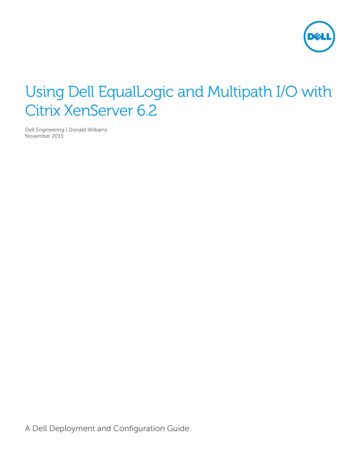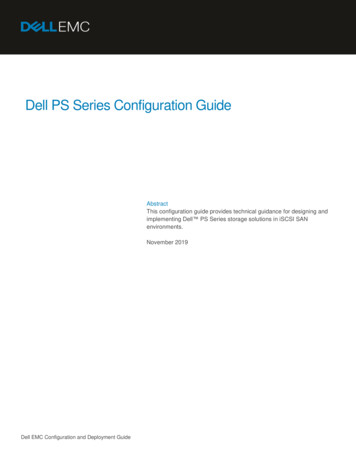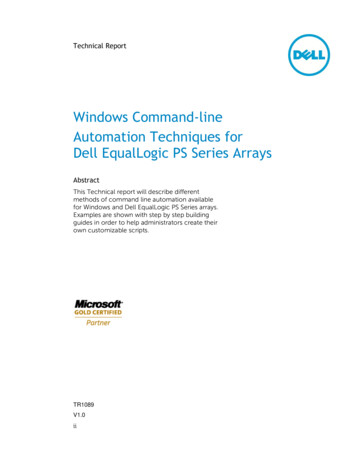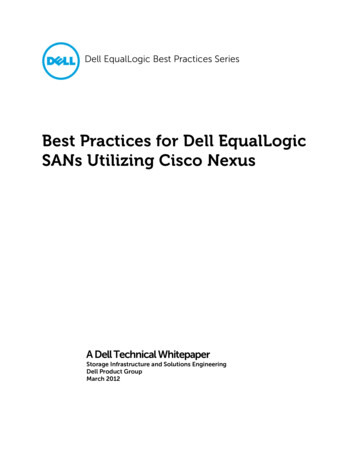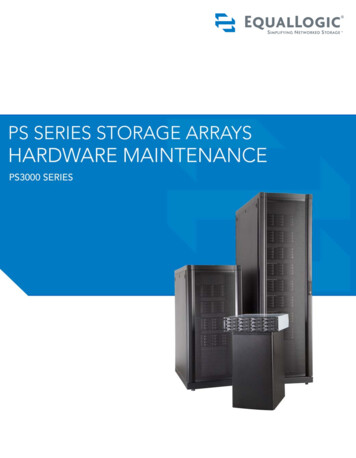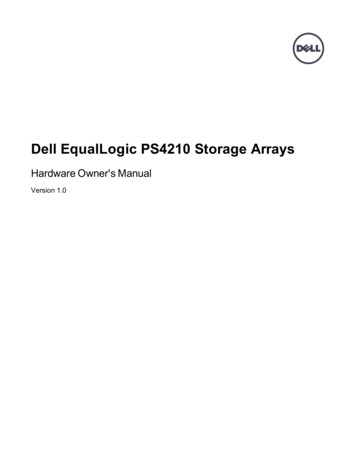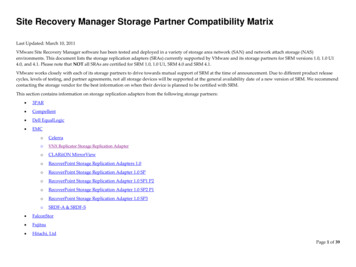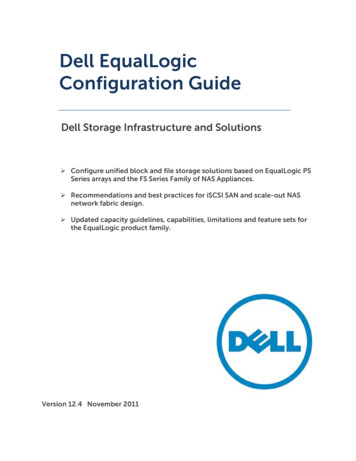
Transcription
Dell EqualLogicConfiguration GuideDell Storage Infrastructure and Solutions Configure unified block and file storage solutions based on EqualLogic PSSeries arrays and the FS Series Family of NAS Appliances. Recommendations and best practices for iSCSI SAN and scale-out NASnetwork fabric design. Updated capacity guidelines, capabilities, limitations and feature sets forthe EqualLogic product family.Version 12.4 November 2011
AbstractThis configuration guide provides technical guidance for designing and implementing Dell EqualLogicPS Series storage solutions in iSCSI SAN environments. The goal of this guide is to provide a singlereference for product technical information and recommended SAN and NAS design methods: Details on the capacity and capabilities of different EqualLogic PS Series family and FS Seriesfamily of NAS AppliancesAn overview of the peer storage feature set provided by the EqualLogic storage controllers andthe NAS feature set provided by the FS Series NAS ServiceiSCSI SAN design guidelines for optimizing redundancy, availability and performance ofEqualLogic storage arrays.Host configuration guidelines and recommendations for Ethernet switch configurationThis document should be used strictly as a guide in planning an EqualLogic SAN solution. It should notbe considered a statement of support for any specific configuration. Actual viability of anyconfiguration will depend on the capabilities of the individual components (switches, networkinterface controllers, initiators, etc.) that make up the SAN infrastructure.This configuration guide is intended for storage administrators, SAN designers, storage consultants, oranyone who is considering purchasing or has purchased an EqualLogic PS Series Array(s) for use in aproduction storage area network.THIS WHITE PAPER IS FOR INFORMATIONAL PURPOSES ONLY, AND MAY CONTAIN TYPOGRAPHICAL ERRORS ANDTECHNICAL INACCURACIES. THE CONTENT IS PROVIDED AS IS, WITHOUT EXPRESS OR IMPLIED WARRANTIES OF ANY KIND. 2011 Dell Inc. All rights reserved. Reproduction of this material in any manner whatsoever without the express writtenpermission of Dell Inc. is strictly forbidden. For more information, contact Dell.Dell, the DELL logo, and the DELL badge, PowerConnect , Dell EqualLogic , PowerEdge and PowerVault are trademarksof Dell Inc. Broadcom is a registered trademark of Broadcom Corporation. Intel is a registered trademark of IntelCorporation in the U.S. and other countries. Microsoft , Windows , Windows Server , and Active Directory are eithertrademarks or registered trademarks of Microsoft Corporation in the United States and/or other countries.Dell EqualLogic Configuration Guide v12.4ii
Revision HistoryRevisionDateChanges12.4November2011 New sections and other changes throughout the document toinclude coverage of FS Series NAS Appliance (FS7500)12.3October2011 Updates for PS4100/PS6100 family arrays: controller details;vertical port failover; SAN configuration guidelines; RAID levelcapacity tables12.2.1July 2011 Corrected Spanning Tree portfast guidance in Appendix D.12.2May 2011 Updated figures and content additions to Replication section12.1March 2011 Section 3.3.7: ReplicationSection 4.6: Integrating 1GbE and 10GbE SANsSection 2.1: Supported Configuration Limits (maintainingconsistency with current firmware release notes)Appendix B and Appendix C: Content removed and nowpublished as a separate Validated Components List document All significant changes included in the most recent version ofthis document are highlighted using blue text, just as this note is.Dell EqualLogic Configuration Guide v12.4ii
Table of ContentsTable of Contents . iii1Introduction . 11.12PS Series Storage Arrays . 22.1Array Models . 22.2PS Series Supported Configuration Limits . 32.3PS Series Storage Array Controllers . 42.3.1Controller Types in all models prior to PS4100/PS6100 . 42.3.2Controller Redundancy in all models prior to PS4100/PS6100 . 52.3.3Controller Failover behavior in all models prior to PS4100/PS6100 . 52.3.4Controller Types in PS4100/PS6100 models . 82.3.5Controller Redundancy in PS4100/PS6100 controllers . 82.3.6Controller failover behavior: PS4100/PS6100 . 82.3.7Vertical Port Failover behavior in PS4100/PS6100 Controllers . 102.3.8Controller Firmware .122.43Audience . 1RAID Policies and Sizing Tables . 142.4.1RAID 5 Drive Layouts and Total Raw Storage.152.4.2RAID 6 Drive Layouts and Total Raw Storage . 162.4.3RAID 10 Drive Layouts and Total Raw Storage . 172.4.4RAID 50 Drive Layouts and Total Raw Storage . 18PS Series Block Level Operations . 193.1Groups . 193.2Pools . 193.3Volumes .213.3.1Volume Attributes .213.3.2Volume Features . 223.4Thin Provisioning . 223.5Snapshots. 233.6Clones . 243.7Template volumes and thin clones . 25Dell EqualLogic Configuration Guide v12.4iii
3.83.8.1Replication Limits . 253.8.2Replication Paths . 263.8.3Replication Process . 273.8.4Fast failback . 303.8.5Sizing Replica Reserve and Delegated Space . 303.8.6Effect of TCP Window Size on Latency across WAN links . 323.94Replication . 25Clustering . 33EqualLogic SAN Design . 344.1Implementation of Standards. 344.2General Requirements and Recommendations . 354.2.14.3Ethernet Switches and Infrastructure . 364.3.1Connecting SAN Switches in a Layer 2 Network . 384.3.2Sizing Inter- Switch Connections . 404.3.3Comparing Inter- Switch Connection Types . 414.4Block I/O Host Configuration Guidelines . 424.4.1Design guidelines for host connectivity in a redundant SAN . 424.4.2Multi- Path I/O . 434.5EqualLogic iSCSI SAN Design . 454.5.1Redundant SAN Configuration. 454.5.2Partially Redundant SAN Configurations . 474.5.3Minimum Cabling Scenarios: PS4100 and PS6100 . 494.65Quality of Service (QoS) . 36Integrating 1GbE and 10GbE SANs .514.6.1Design considerations . 524.6.2Mixed SAN best practices . 54FS Series NAS Appliance . 555.1FS Series Architecture . 555.1.1FS Series solution for file only storage. 565.2Dell FluidFS . 575.3FS Series Models . 585.3.1FS7500 Supported Configuration Limits . 585.3.2FS7500 System Components . 59Dell EqualLogic Configuration Guide v12.4iv
5.3.36FS7500 file system operation on controller failover . 60FS Series File Level Operations . 616.1NAS Service . 616.2NAS Reserve . 616.2.16.3NAS File Systems . 626.3.16.47Relationship between PS Series Groups, Pools and NAS Reserve . 61NAS File System security styles . 63File System Snapshots . 64FS Series NAS Configuration . 657.18FS7500 Connection Paths . 65M1000e Blade Chassis Integration. 688.1Guidelines for Stacking Switches in a Blade Chassis . 688.2Single M1000e Enclosure Integration . 698.3Multiple M1000e Enclosure Integration . 698.4M1000e Ethernet Pass- Through I/O Module . 718.5External Tier Stacking . 718.6Stack to Stack Interconnect . 718.6.110GbE Uplink Recommendations . 718.6.21GbE Uplink Recommendations . 73Appendix ANetwork Ports and Protocols . 76A.1Required Ports and Protocols . 76A.2Optional Ports and Protocols. 76Appendix BRecommended Switches . 77Appendix CSupported iSCSI Initiators . 77Appendix DPowerConnect 54xx Switch Configuration . 78D.1Disabling iSCSI Optimization Setting . 78D.2Enabling the PortFast Option to Configure STP Edge Ports . 79D.3Configuring Flow Control . 79D.4Disabling Unicast Storm Control . 80D.5Configuring Jumbo Frames . 80Appendix EPowerConnect 62xx Switch Configuration . 81E.1Interface Naming Convention . 81E.2Enabling the PortFast Option to Configure STP Edge Ports . 82Dell EqualLogic Configuration Guide v12.4v
E.3Configuring Flow Control . 82E.4Disabling Unicast Storm Control . 82E.5Configuring Jumbo Frames . 83Appendix FCisco IOS based Switch Configuration . 84F.1Enabling the PortFast Option to Configure STP Edge Ports . 85F.2Configuring Flow Control . 85F.3Disabling Unicast Storm Control . 86F.4Configuring Jumbo Frames . 86Related Publications . 88Dell EqualLogic Configuration Guide v12.4vi
1 IntroductionWith the Dell EqualLogic PS Series of storage arrays Dell provides a storage solution that deliversthe benefits of consolidated networked storage in a self- managing, iSCSI storage area network (SAN)that is affordable and easy to use, regardless of scale. By eliminating complex tasks and enabling fastand flexible storage provisioning, these solutions dramatically reduce the costs of storage acquisitionand ongoing operations.To be able to leverage the advanced features provided by an EqualLogic array, a robust, standardscompliant iSCSI storage area network (SAN) infrastructure must be created. While almost any industrystandard, enterprise class Ethernet switch can be used to connect hosts to the EqualLogic- basedvirtual storage volumes, some switches, network interface controllers(NICs), iSCSI Host Bus Adapters(HBAs), and iSCSI initiators can directly impact the overall performance of the SAN storage solution.The Dell EqualLogic Configuration Guide is provided as an aid to help storage administratorsdetermine how best to build an iSCSI infrastructure for use within an EqualLogic SAN solution. Thisdocument focuses on network configuration, host integration and other topics that help to ensure asmooth deployment with optimum PS Series SAN and FS Series NAS appliance performance.Note: This version of the EqualLogic Configuration Guide (v12.4, 11/2011) introduces coverageof the EqualLogic FS Series Family of NAS appliances.The FS Series NAS appliance extends the EqualLogic storage family with powerful scale- outNAS capabilities. With the addition of FS Series NAS functionality, the EqualLogic productfamily now provides an iSCSI based unified file and block storage platform. An EqualLogicSAN can now be used to provide block level access (direct iSCSI access to PS Series arrays) orfile system level access (via the FS Series appliance) using NFS or CIFS protocols and the DellFluidFS scale- out file system.Unless otherwise stated, recommendations in this document are applicable to both file andblock environments.This document should be used strictly as a guide in planning an EqualLogic storage solution. It shouldnot be considered a statement of support for any specific configuration. Actual viability of anyconfiguration will depend on the capabilities of the individual components (switches, networkinterface controllers, initiators, etc.) that make up the SAN infrastructure.1.1 AudienceThis configuration guide is intended for storage administrators, SAN/NAS system designers, storageconsultants, or anyone who is considering purchasing or has purchased EqualLogic PS Series storageor FS Series Array appliances for use in a production storage area network. It is assumed that allreaders have experience in designing and/or administering a shared storage solution. Also, there aresome assumptions made in terms of familiarity with all current and possibly future Ethernet standardsas defined by the Institute of Electrical and Electronic Engineers (IEEE) as well as all TCP/IP and iSCSIstandards as defined by the Internet Engineering Task Force (IETF).Dell EqualLogic Configuration Guide v12.41
2 PS Series Storage ArraysPS Series Storage SANs provide a peer storage architecture comprised of one or more independentarrays. Each array contains its own controllers, cache, storage, and interface ports. Grouped togetherthey can create one or more single instance storage pools that are based on the IETF iSCSI standard.The capabilities of the PS Series solution are provided through a unique set of software and hardwarecapabilities that, when used cooperatively, can provide a full featured SAN solution. The followingsections provide additional insight into specifications and functions of PS Series arrays.2.1 Array ModelsThe array models available prior to introduction of the PS4100/PS6100 family are shown in Table 1below.Array ModelDrive TypeNumber of DrivesPS50E – PS2400ESATAPS3000X, PS3x00XVSAS16PS4000ESATA16PS4000X, PS4000XVSAS16PS5000ESATA16PS5000X, PS5000XVSAS16PS5500ESATA48PS6000ESATA16PS6000X, PS6000XVSAS16PS6000S, PS6010SSSD16PS6010ESATA16PS6010X, PS6010XVSAS16PS6000XVS, PS6010XVSSAS / SSD8/8PS6500ESATA48PS6510ESATA48PS6510XSAS48(a)14, 16(a) PS2400E comprised of 4 drive enclosures, 14 drives eachTable 1: Array Models prior to PS4100/PS6100Starting with the introduction of the PS4100 and PS6100 family of arrays, configurations using 2.5” and3.5” disks are available.Array ModelDrive TypeNumber of DrivesPS4100E3.5” SAS 7.2K RPM12PS4100X2.5” SAS 10K RPM24PS4100XV2.5” SAS 15K RPM24PS4100XV3.5” SAS 15K RPM12Dell EqualLogic Configuration Guide v12.42
PS6100E3.5” SAS 7.2K RPM24PS6100X2.5” SAS 10K RPM24PS6100XV2.5” SAS 15K RPM24PS6100XV3.5” SAS 15K RPM24PS6100SSSD12 or 24PS6100XSSSD SAS 10K RPM7 SSD 17 SASTable 2: PS4100/PS6100 Array Models2.2PS Series Supported Configuration LimitsThe Dell EqualLogic PS6xxx Series provides the full range of features and capabilities available with theEqualLogic PS Series storage products. The Dell EqualLogic PS4xxx Series provides a subset offeatures and capabilities, targeted at remote office and small to medium business storagedeployments. The supported configuration limits for a PS Series group provided in Table 3.Table 3 Supported Configuration LimitsPS4000/PS4100 GroupsaOnlyConfigurationVolumes and replica sets per groupVolume size512cVolumes enabled for replication (outbound)dSnapshots and replicas per grouphAll Other Groups102415 TB15 TB32256204810,000Snapshots per volume128512Replicas per volume128512Schedules (snapshot or replication) pervolume or volume collection1616Persistent Reservation registrants per volume9696Replication partners per group1616Replication partners per volume11Members per group216Members per pool28Pools per group24Volumes per collection88100100Collections per group (snapshot andreplication)bahVolume connections (each time an iSCSIinitiator connects to a volume counts as ae,fconnection)512 per pool1024 per group with 2 pools1024 per pool4096 per group with 4poolsAccess control records per volume and itssnapshots1616Simultaneous management sessions (anycombination of GUI, telnet, or scriptingsessions)7710% of volume size10% of volume sizeiThin provisioning limits(minimum allocation)Dell EqualLogic Configuration Guide v12.4g3
Administrator accounts per group100100(a) A group can contain a maximum of two (2) PS4000 and/or PS4100 arrays.(b) Includes groups of mixed array types and all other group types except groups containing only PS4000 arrays. When agroup contains a mix of PS4000 arrays and other array models, the higher limits prevail.(c) Practical maximum volume size is operating system- specific. A PS Series group can create and present volumes up to15 TB.(d) Up to 16 simultaneous replication operations can take place.(e) To avoid service outages or possible loss of connectivity during failovers, Dell recommends increasing initiator(f)(g)(h)(i)timeouts for groups with more than 512 connections. See the iSCSI Initiator and Operating Systems Considerationsdocument for more information.Inbound replication connections count towards the total number of connections.With firmware version 5.1, maximum number of volumes per group and maximum number of connections per poolincreased from 256 to 512Up to 1024 connections per pool are supported for all groups except groups containing only PS4000 arrays. Thisprovides increased scalability in virtualized environments. These connections may be distributed across a maximum of512 volumes.Volumes automatically created and managed by the NAS Service inside the NAS Reserve pool used by an FS Seriesappliance are fully allocated at creation and cannot be thin provisioned. Once those volumes are created (when theNAS Reserve is created they cannot be shrunk.2.3 PS Series Storage Array ControllersSince the EqualLogic PS Series was introduced, there have been several different array modelsreleased with new features, better performance and greater storage capacity. The storage arraycontrollers were also improved to take advantage of advances in the underlying networking andstorage technologies.2.3.1Controller Types in all models prior to PS4100/PS6100Array controllers can be identified and differentiated by the controller "type" designation. Eachcontroller type will have a different colored label to help quickly identify the controller type. Table 4lists each Dell EqualLogic controller along with some characteristics about geTypeNotesType 13 x 1GbaseT3 x 1Gb SFP (combo)SATA Original ControllerDesign PS50 – PS2400 1GB CacheType 23 x 1GbaseT3 x 1Gb SFP (combo)SATA PS50 – PS2400 1GB Cache3 x 1GbaseTSASSATA PS3000 – PS5000 1GB Cache Cannot mix Type 3 SASwith Type 3 SATASAS PS3000 – PS5000 1GB Cache Cannot mix Type 3 SASwith Type 4 controllerType 3 SASType 3 SATAType 4Dell EqualLogic Configuration Guide v12.43 x 1GbaseT4
Type 53 x 1GbaseTSATA PS3000 – PS5000 1GB Cache Cannot mix Type 3 SASwith Type 5 controllerType 63 x 1GbaseTSATA PS5500 only 2GB Cache4 x 1GbaseTSASSATASSD PS6000 – PS6500 2GB Cache Cannot mix SAS andSATA drives in samearraySASSATA PS4000 only 2GB Cache Cannot mix SAS andSATA drives in samearrayType 72 x1GbaseT1 x 10/100Mb mgtType 8ndType 92 x 1GbaseT1 x 10/100Mb mgtSASSATA 2 generation PS4000 2GB Cache Cannot mix SAS andSATA drives in samearrayType 102 x 10GB SFP 1 x 10/100Mb mgtSASSATASSD 10Gb Ethernet PS6010 – PS6510 2GB CacheTable 4: Array Controller Types – all models prior to PS4100/PS61002.3.2Controller Redundancy in all models prior to PS4100/PS6100Each array can be configured with either a single controller, or dual redundant controllers. The singlecontroller configuration will provide the same level of I/O performance as a dual controllerconfiguration. The dual controller configuration provides for redundancy. Redundant controllers willprevent volume connections between hosts and SAN from being dropped in the event of an activecontroller failure.The Active Controller is the controller which is processing all disk and network I/O operations for thearray. A second controller in dual controller configurations will always be in a “passive” operatingmode. In this mode, the secondary controller will exhibit the following characteristics: 2.3.3Each of its Ethernet ports are electrically inactive (active lights are off)The passive controller cache mirrors the cache of the active controller.Controller Failover behavior in all models prior to PS4100/PS6100To support redundant controller fail over, each Ethernet port on the active controller that is connectedto the SAN must have its corresponding port on the passive controller also connected to the sameSAN network. In the event of a controller failure, the passive controller will immediately activate andcontinue to process all data requests to the array. The following changes occur during fail over:Dell EqualLogic Configuration Guide v12.45
The backup controller automatically enables each of the corresponding Ethernet ports thatwere enabled on the failed primary controllerThe
Dell EqualLogic Configuration Guide v12.4 ii Abstract This configuration guide provides technical guidance for designing and implementing Dell EqualLogic PS Series storage solutions in iSCSI SAN environments. The goal of this guide is to provide a single reference for product technical information and recomme nded SAN and NAS design methods:
